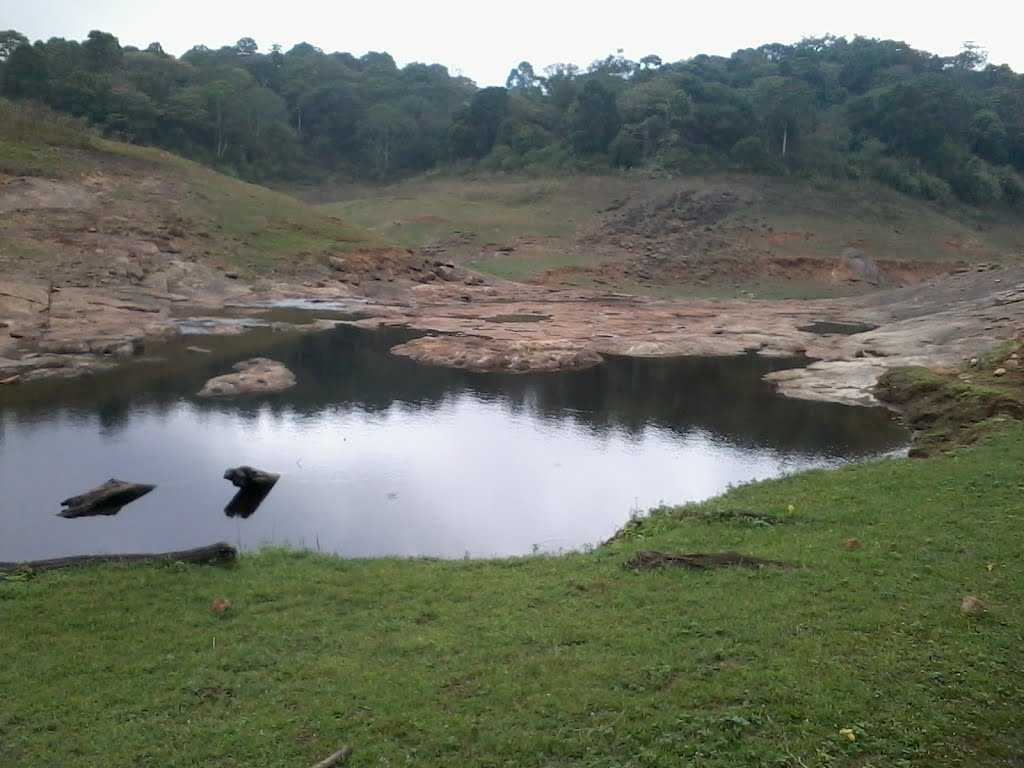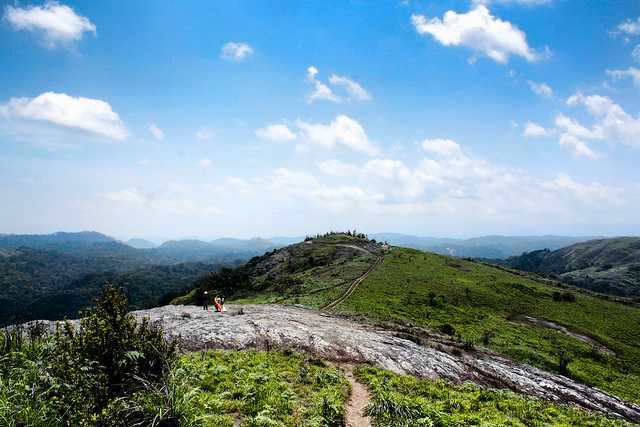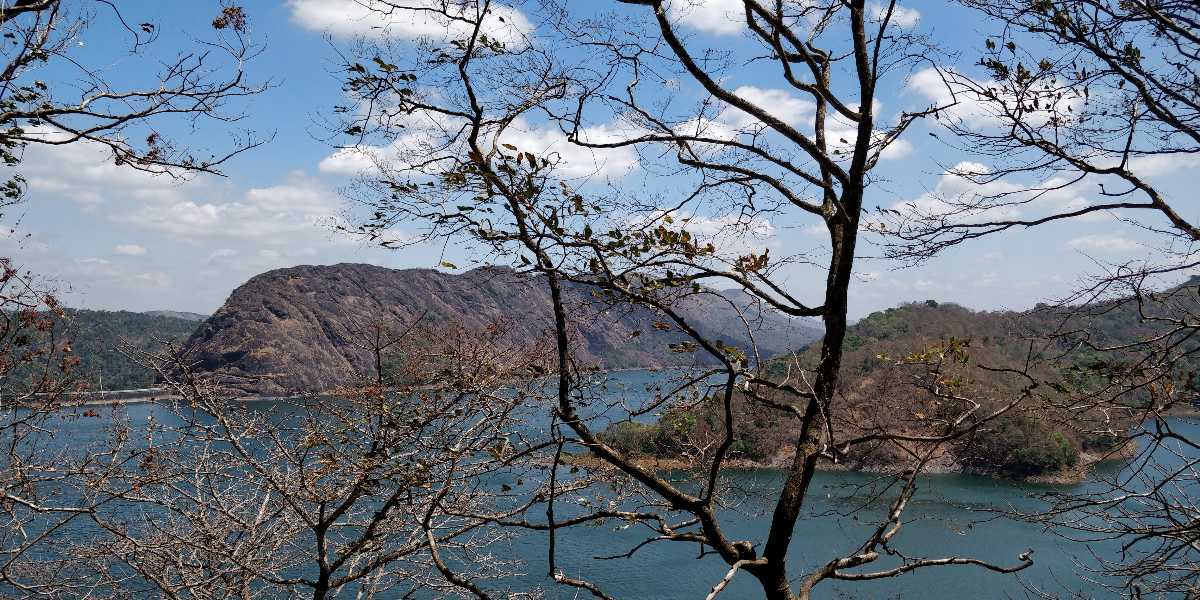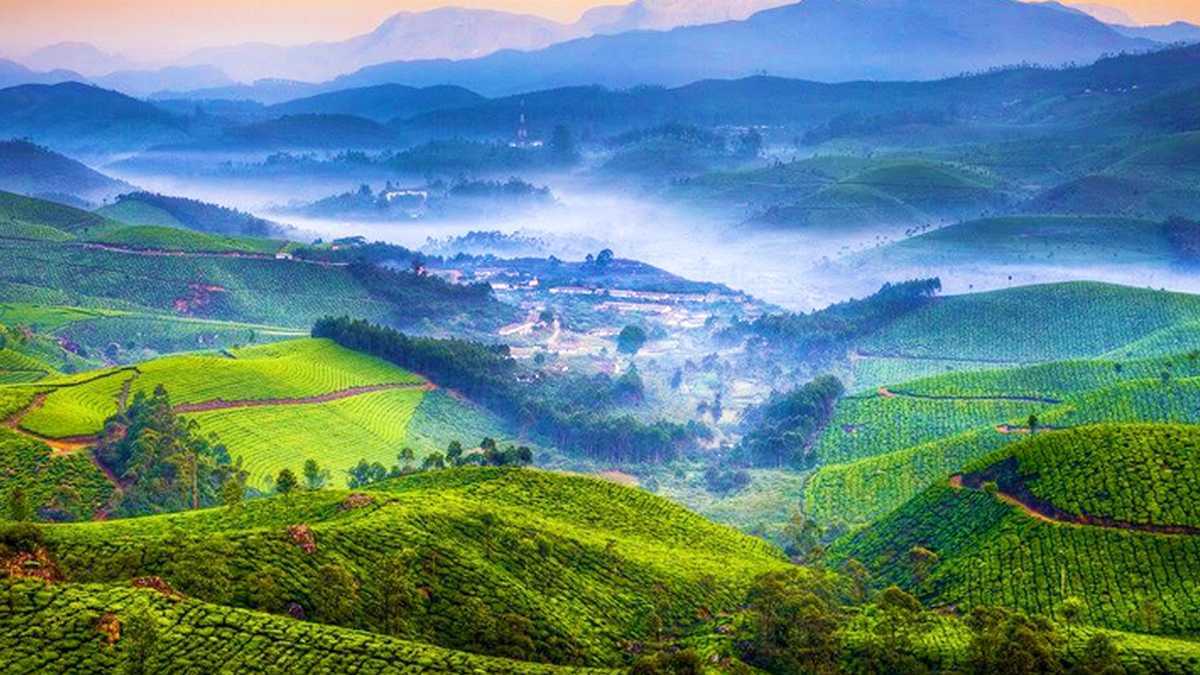SABARIMALA
Are you tired of the same old religious destinations? Do you want to explore a place that is unique, funny, and interesting? Look no further than Sabarimala, the famous pilgrimage center in Kerala, India.
This is not your typical pilgrimage spot. Here, men have to follow strict rules like observing celibacy for 41 days and wearing black clothes. Women between the ages of 10 and 50 are completely banned from entering the temple.
Wait, what? Yes, you read that right. Women are not allowed to enter the temple because of a belief that they could possibly menstruate and therefore make the temple impure. This rule has been challenged several times in court but has yet to be overturned.
But don't let these restrictions discourage you from visiting! Sabarimala is known for its beautiful natural scenery, including waterfalls and forests. And if you're lucky, you might even see some wild elephants along the way.
Just be prepared to climb a few hundred stairs before reaching the temple. But hey, it's all worth it for a glimpse of Lord Ayyappa who is believed to reside there.
So pack your bags and get ready for an adventure like no other at Sabarimala!
Table of Contents
- Introduction
- History and Culture of Sabarimala
- How to Reach and getting around Sabarimala
- Weather of Sabarimala
- Places to Visit in Sabarimala
- Food Options and Local Cuisine of Sabarimala
- Best areas for Accommodation in Sabarimala
- Shopping in Sabarimala
- Nightlife in Sabarimala
- Festivals and Events in Sabarimala
- Tips for Travelers travelling to Sabarimala
- FAQs
History and Culture of Sabarimala
Sabarimala is a famous pilgrimage site located in the Western Ghats of Kerala, India. It is known for its unique customs and traditions that make it different from other Hindu temples. The history of Sabarimala dates back to ancient times when the temple was believed to be a place of meditation for sages and saints.
According to legend, Lord Ayyappan, the presiding deity of Sabarimala, was born out of the union between Lord Shiva and Lord Vishnu. The temple's rituals and practices are based on this mythological story.
The culture of Sabarimala revolves around strict rules and regulations that devotees must follow before visiting the temple. Men who wish to visit the temple must observe a 41-day fasting period and wear black clothes. Women between the ages of 10-50 are not allowed to enter the temple.
Despite its strict customs, Sabarimala attracts millions of devotees every year. The annual pilgrimage season or "Mandalam" starts in mid-November and ends in mid-January.
During this time, pilgrims from all over India come together to climb up the hill where the temple is situated. The trek involves climbing up steep steps, crossing rivers, and enduring harsh weather conditions.
Apart from its religious significance, Sabarimala is also famous for its natural beauty. The surrounding hills are covered with dense forests that are home to several exotic species of flora and fauna.
In conclusion, Sabarimala is a unique blend of religious devotion, ancient traditions, and natural beauty. It's an experience unlike any other that every Hindu should witness at least once in their lifetime (but ladies under 50 years old might want to skip this one).
How to Reach and getting around Sabarimala
By Air:
The nearest airport to Sabarimala is the Cochin International Airport, which is located around 160 km away. From the airport, you can hire a taxi or take a bus to reach Sabarimala. Another option is to fly to Trivandrum International Airport, which is located around 170 km away.
By Train:
The nearest railway station to Sabarimala is Chengannur railway station, which is located around 90 km away. From the station, you can take a taxi or a bus to reach Pamba, which is the starting point of the trek to Sabarimala.
By Road:
Sabarimala can be reached by road from various parts of Kerala and Tamil Nadu. There are regular bus services from major cities like Kochi, Trivandrum, Chennai and Bangalore. Private taxis are also available for hire.
Trek:
One of the most popular ways to reach Sabarimala is by trekking through the dense forests of Western Ghats. The trek starts from Pamba and takes around 3-4 hours to reach Sabarimala. The trek route passes through beautiful landscapes and offers stunning views of the surrounding hills.
Helicopter Service:
A helicopter service operates during the pilgrimage season between Pamba and Nilackal, which reduces the travel time significantly. It takes only 6 minutes to travel by helicopter from Pamba to Nilackal.
Private Vehicle:
You can also drive your own vehicle or hire a private car/taxi to reach Sabarimala. However, it is important to note that private vehicles are not allowed beyond Pamba during the pilgrimage season.
No matter what mode of transportation you choose, reaching Sabarimala will be an unforgettable experience that will stay with you forever.
Weather of Sabarimala












 Extreme Winters
Extreme Winters Mild Winters
Mild Winters Hot + Dry
Hot + Dry Hot + Humid
Hot + Humid Rainy
Rainy Cool and Pleasant
Cool and PleasantSabarimala, a famous pilgrimage site located in the Western Ghats of Kerala, experiences a tropical climate. The weather in Sabarimala is usually pleasant and temperate throughout the year. The monsoon season starts from June to September, during which the region receives heavy rainfall. The winter season commences from November to February, and the weather remains cold and misty.
The best time to visit Sabarimala is during the months of November to January when the weather is cool and dry. The temperature ranges from 10°C to 25°C, making it an ideal time for trekking and other outdoor activities. Moreover, this time coincides with the annual pilgrimage season when millions of devotees come to visit Lord Ayyappa's temple.
During summer (March - May), the temperature can rise up to 35°C, which can be uncomfortable for travelers. However, if you want to avoid crowds, this could be a good time as there are fewer visitors during this period.
In conclusion, if you are planning a trip to Sabarimala, then plan it between November and January for a comfortable and enjoyable experience. However, be prepared for long queues during peak season as it attracts devotees from all over India.
Places to Visit in Sabarimala
Sabarimala Sree Ayyappa Temple: The Sabarimala Sree Ayyappa Temple is the main attraction of the Sabarimala pilgrimage. It is believed that Lord Ayyappa meditated here after killing the demon Mahishi. The temple is open only for a few months in a year, and millions of devotees visit it to seek blessings from Lord Ayyappa.
Malikappuram Devi Temple: The Malikappuram Devi Temple is located on the way to Sabarimala and is dedicated to Goddess Durga. It is said that Lord Ayyappa had halted at this place before reaching Sabarimala, and it holds great significance for the devotees.
Erumeli Sree Dharmasastha Temple: The Erumeli Sree Dharmasastha Temple is another significant temple on the way to Sabarimala. It is believed that Lord Ayyappa had taken his first steps towards Sabarimala from here after completing his martial arts training.
Pampa River: The Pampa River flows through the foothills of Sabarimala and offers a serene view with its calm waters and lush green surroundings. Pilgrims take a dip in the river before ascending uphill to reach the temple.
Neelimala Viewpoint: The Neelimala Viewpoint offers a breathtaking view of the surrounding mountains and valleys, making it a perfect spot for nature lovers and photography enthusiasts.
Periyar Wildlife Sanctuary: The Periyar Wildlife Sanctuary, located near Sabarimala, is home to a diverse range of flora and fauna, including elephants, tigers, leopards, and more than 265 species of birds.
Kanthanpara Waterfalls: Kanthanpara Waterfalls are situated near Meppadi in Wayanad district and are known for their scenic beauty amidst dense forests.
Vavar Shrine: The Vavar Shrine is located towards the eastern side of the main temple complex and is dedicated to Vavar Swamy, who was believed to be a close friend of Lord Ayyappa.
Chalakayam Waterfalls: Chalakayam Waterfalls are located near Thiruvalla town in Pathanamthitta district and are known for their stunning beauty amidst lush green forests.
Gavi Eco-Tourism: Gavi Eco-Tourism offers visitors an opportunity to explore nature trails amidst pristine forests teeming with wildlife like elephants, tigers, leopards, etc., making it an ideal destination for eco-tourism enthusiasts.
Adventures Activities
Religious Shrines
Relaxing Retreats
Hilly Regions
Food Options and Local Cuisine of Sabarimala
Best areas for accommodation in Sabarimala
Accommodation Areas in Sabarimala
Sabarimala is a popular pilgrimage site in Kerala, India. Every year, millions of devotees visit this holy site to pay their respects to Lord Ayyappa. The area has a range of accommodation options for visitors, from luxury hotels to budget lodges.
The best areas for accommodation in Sabarimala are:
- Pampa: This is the main base camp for Sabarimala pilgrims. It is located at the foothills of the shrine and has several accommodation options including hotels, lodges and dormitories.
- Nilakkal: This is another base camp for Sabarimala pilgrims. It is located around 20 km away from Pampa and has several accommodation options including hotels and lodges.
- Erumeli: This town is located around 12 km away from Pampa and is a popular stopover point for Sabarimala pilgrims. It has several budget-friendly accommodation options.
Properties for Accommodation in Sabarimala
- Hotel Hilltop: This luxury hotel is located in Pampa and offers comfortable rooms with modern amenities like air conditioning, flat-screen TVs and en suite bathrooms. The hotel also has a restaurant that serves Indian and international cuisine.
- Sree Gokulam Vanamala: This budget-friendly lodge is located in Nilakkal and offers clean rooms with basic amenities like fans and en suite bathrooms. The lodge also has a restaurant that serves vegetarian food.
- Sabari Lodge: This hostel is located in Erumeli and offers dormitory-style accommodations at affordable rates. The hostel also has a common dining area where guests can enjoy meals together.
Shopping in Sabarimala
Sabarimala, a famous pilgrimage center in Kerala, is not just known for its religious significance but also for the shopping experience it provides to its visitors. From traditional clothes to handicrafts and religious artifacts, the markets of Sabarimala have something for everyone. Here are some things to buy, markets to visit, and things to avoid during your shopping trip in Sabarimala.
Things to Buy
- Traditional Kerala clothes such as Mundu and Veshti
- Handicrafts made by local artisans like coconut shell crafts and wood carvings
- Religious artifacts like Rudraksha malas and brass lamps
- Ayurvedic medicines made from natural ingredients
Markets to Visit
- Pamba market located at the base of Sabarimala hill where you can buy offerings for Lord Ayyappa
- Nilakkal market on the way to Sabarimala where you can buy souvenirs and traditional items
- Sannidhanam market near the temple where you can find a variety of religious items including books, CDs, and DVDs
What to Avoid
- Buying from unauthorized vendors who sell fake or low-quality products
- Carrying too much cash while shopping as pickpocketing incidents are common in crowded areas
- Purchasing non-permitted items like plastic bottles, cigarettes, and alcohol as they are strictly prohibited in Sabarimala
- Bargaining too much as it may offend local vendors who follow a fair pricing policy
In conclusion, shopping in Sabarimala is an enjoyable experience where you can find unique items that reflect the rich culture of Kerala. By keeping these tips in mind, you can make your shopping trip safe and hassle-free.
Nightlife in Sabarimala
Sabarimala is a pilgrimage site located in the Western Ghats of Kerala, India. It is known for its famous temple dedicated to Lord Ayyappa, which attracts millions of devotees every year. However, Sabarimala also offers a unique nightlife experience that is worth exploring.
There are several places in Sabarimala where one can spend the night and enjoy the local nightlife. Here are three suggestions:
Pamba River: The Pamba River is a popular spot for tourists to spend the night in Sabarimala. There are several houseboats available for rent that offer a comfortable stay on the river. The houseboats come equipped with all modern amenities and provide picturesque views of the surrounding hills.
Vazhachal Waterfalls: The Vazhachal Waterfalls are a great place to spend the night in Sabarimala. There are several campsites available near the falls that offer a unique camping experience. Visitors can enjoy activities like trekking, bird watching, and bonfires at night.
Periyar National Park: The Periyar National Park is another great place to spend the night in Sabarimala. There are several eco-lodges and resorts available within the park that offer comfortable accommodation. Visitors can go on jungle safaris, bird watching tours, and nature walks during the day.
Overall, Sabarimala offers a unique nightlife experience that is unlike anything else in India. Whether you want to relax on a houseboat, camp under the stars, or explore nature in Periyar National Park, there's something for everyone here at night.
Outdoor Activities in Sabarimala
After a long day of exploring the religious and cultural attractions in Sabarimala, it's time to unwind with some outdoor activities. The lush greenery and scenic landscapes of this region make it an excellent destination for nature lovers and adventure enthusiasts. From trekking to camping, there are plenty of options to choose from.
Trekking is one of the most popular outdoor activities in Sabarimala. The region boasts several scenic trekking trails that take you through dense forests, glistening waterfalls, and picturesque valleys. Some of the popular trekking trails include Neelimala Viewpoint, Pamba-Kalaketty Trail, and Sabari Hills Trek.
Camping is another exciting activity that you can indulge in while in Sabarimala. You can set up your camp in one of the many serene locations around the region and spend a night under the stars. Enjoy a bonfire with your friends or family while relishing some delicious local cuisine.
River Rafting is also gaining popularity as an adventure activity in Sabarimala. The Pamba River offers thrilling rapids for rafting enthusiasts. It is an excellent way to explore the natural beauty of the region while experiencing an adrenaline rush.
In conclusion, Sabarimala offers an array of outdoor activities that cater to different interests and preferences. So, pack your bags and head out to this beautiful destination for an unforgettable experience!
Festivals and Events in Sabarimala
Sabarimala is a popular pilgrimage destination for Hindus, and it hosts several festivals and events throughout the year. These events attract millions of devotees from all over the world who come to offer their prayers and seek blessings at the Sabarimala temple.
Below are some of the major festivals and events that take place in Sabarimala:
Mandala Pooja (November-December): This is a 41-day long festival that begins in mid-November and ends in late December. During this festival, devotees observe strict vows of abstinence, wear black clothes, and carry irumudi kettu (a two-compartment bag containing offerings for Lord Ayyappa). The main day of the festival is Mandala pooja day when the temple doors are opened for darshan (viewing) of Lord Ayyappa.
Makaravilakku (January): This is one of the most important festivals in Sabarimala. It marks the end of the Mandalam season and the beginning of Makara season. Thousands of pilgrims gather to witness Makara Jyoti, a divine light that appears on Ponnambalamedu hill.
Vishu (April): Vishu marks the beginning of a new year according to Malayalam calendar. It is celebrated with great enthusiasm by Hindus all over Kerala. At Sabarimala, special poojas are performed on this day.
Onam (August-September): Onam is a harvest festival celebrated by Hindus in Kerala. It is believed that Lord Mahabali visits his subjects during this festival. Special poojas are conducted at Sabarimala during Onam.
Apart from these festivals, there are several other events like Chitra Vishu, Thiruvonam Vilakku, and Thiruvabharanam procession that take place throughout the year at Sabarimala. These events add to the spiritual aura of Sabarimala and attract thousands of devotees every year.
Tips for Travelers while travelling to Sabarimala
- Plan your trip ahead: Sabarimala is a pilgrimage site, and it witnesses a massive influx of devotees every year. Hence, it is essential to plan your trip well in advance. Make sure you book your accommodation and transportation in advance to avoid any last-minute hassles.
- Dress appropriately: Sabarimala is a place of worship, and it has a dress code that all devotees must follow. Men are required to wear black or blue dhoti, while women are expected to wear sarees or salwar kameez in black, blue or other dark colors. Avoid wearing flashy clothes or jewelry.
- Carry necessary items: Since Sabarimala is situated in the Western Ghats, the weather can be unpredictable. Hence, carry warm clothes like jackets and shawls as it can get cold at night. Carry enough cash as there are no ATMs near the temple complex.
- Follow the rituals: Sabarimala is known for its strict rituals, and all devotees must follow them during their visit. It includes observing 41 days of vratham (penance), which involves abstaining from alcohol, non-vegetarian food, and other indulgences. Devotees also need to carry irumudi kettu (a cloth bag containing offerings) while climbing up the hill to reach the temple.
- Respect local customs and traditions: Sabarimala is located in a remote area with a unique culture and customs. Respect the local traditions and behave appropriately while interacting with locals. Avoid littering or damaging any natural surroundings.
In conclusion, traveling to Sabarimala can be an enriching experience for devotees who seek spiritual solace. However, one must be mindful of the customs and traditions followed here and plan their trip accordingly to have a peaceful and hassle-free journey.
FAQs
What is Sabarimala?
Sabarimala is a temple located in the Periyar Tiger Reserve, Kerala, India. It is dedicated to Lord Ayyappa, a Hindu deity. The temple attracts millions of pilgrims every year, with the peak season being between November and January.
Why is Sabarimala famous?
Sabarimala is famous for its strict traditions and rituals that are followed by devotees during their pilgrimage to the temple. One of the unique features of this temple is that it allows entry only to men who have observed a 41-day fast and abstain from worldly pleasures during this period.
Are women allowed in Sabarimala?
The Supreme Court of India lifted the centuries-old ban on entry of women of menstruating age (10-50 years) into Sabarimala in September 2018. However, there have been protests against this decision, and some women who attempted to enter the temple faced opposition.
What are the traditions followed by devotees during their pilgrimage to Sabarimala?
Devotees who visit Sabarimala follow strict traditions such as observing a 41-day fast, wearing black or blue clothes, and carrying Irumudi (sacred offering) on their heads. They also climb 18 sacred steps before reaching the sanctum sanctorum.
Is there any dress code for visiting Sabarimala?
Yes, there is a dress code for both men and women visiting Sabarimala. Men are required to wear black or blue clothes while women are expected to wear saree or salwar kameez with a dupatta covering their head.
How can one reach Sabarimala?
Sabarimala can be reached by road, rail, and air. The nearest airport is Kochi International Airport (160 km), while Kottayam railway station (120 km) is the closest railway station. From there, one can hire a taxi or take a bus to reach Pamba, which is the base camp for trekking up to the temple.
What are some dos and don'ts when visiting Sabarimala?
Some dos when visiting Sabarimala include following the dress code, carrying necessary items such as food and water for trekking up to the temple, respecting local customs and traditions. Some don'ts include carrying electronic devices such as mobile phones or cameras inside the temple premises and smoking or consuming alcohol during your visit.




